Research Proposal: Millennials, Social Media, and Fashion Industry
VerifiedAdded on 2023/01/13
|24
|5933
|32
Project
AI Summary
This research proposal investigates the influence of social media communication on the purchase intentions of millennials within the Chinese fashion industry, with Zara as a case study. It explores the background of the research, highlighting the importance of millennials as a key consumer segment and the rapid changes in the fashion industry. The proposal outlines the research problem, purpose, objectives, and hypotheses, emphasizing the need to understand how social media strategies affect consumer behavior. A comprehensive literature review examines social media communication, various social media types, consumer purchase intentions, and the relationship between social media and purchase intention. The methodology section details the research philosophy, approach, design, data collection and analysis methods, sampling strategies, and ethical considerations. The research aims to provide insights into effective strategies for retaining and acquiring millennial consumers in the fashion industry by leveraging social media platforms. The proposal underscores the significance of integrating marketing communication across different platforms to engage with consumers and ultimately influence their purchase decisions.
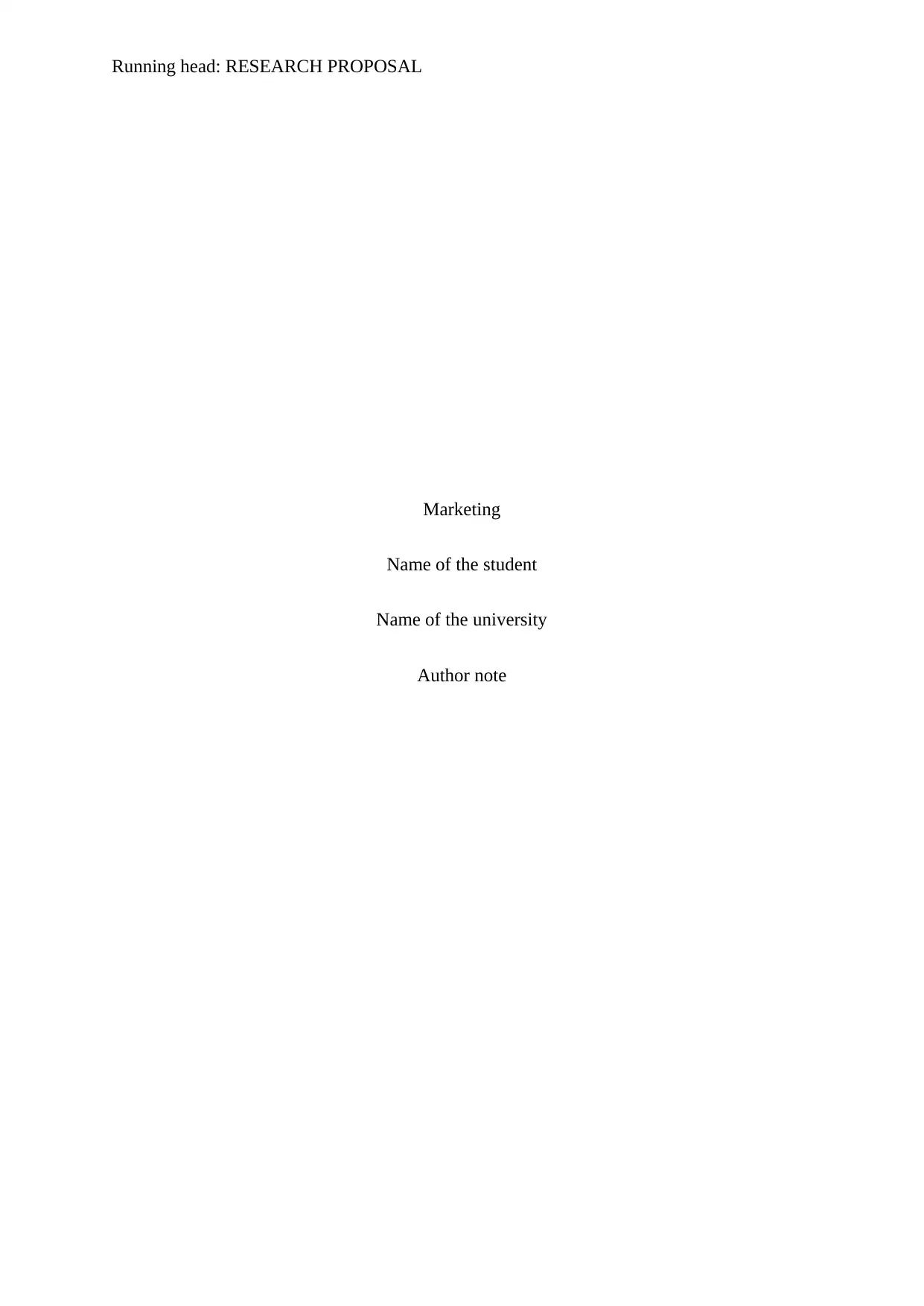
Running head: RESEARCH PROPOSAL
Marketing
Name of the student
Name of the university
Author note
Marketing
Name of the student
Name of the university
Author note
Paraphrase This Document
Need a fresh take? Get an instant paraphrase of this document with our AI Paraphraser
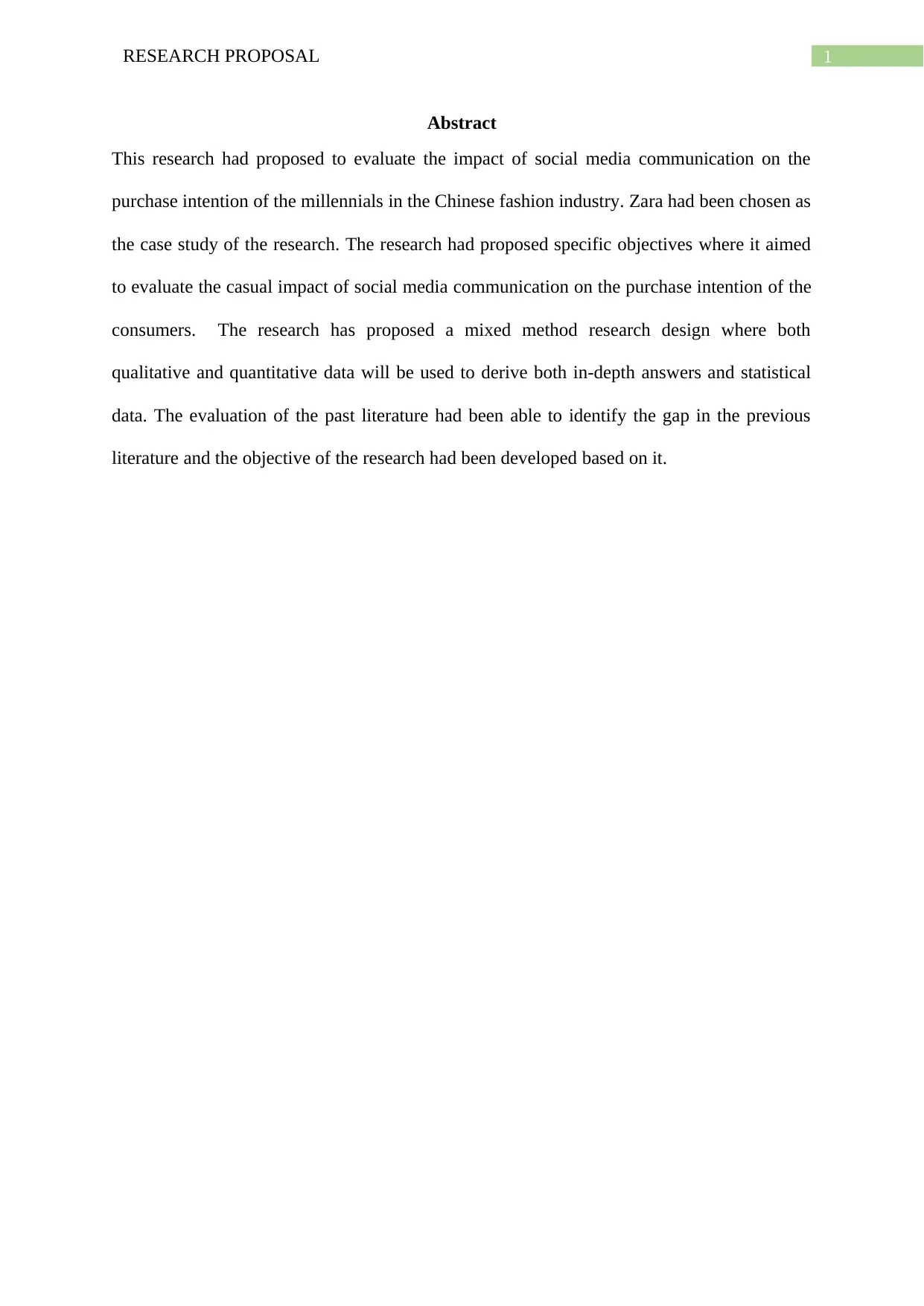
1RESEARCH PROPOSAL
Abstract
This research had proposed to evaluate the impact of social media communication on the
purchase intention of the millennials in the Chinese fashion industry. Zara had been chosen as
the case study of the research. The research had proposed specific objectives where it aimed
to evaluate the casual impact of social media communication on the purchase intention of the
consumers. The research has proposed a mixed method research design where both
qualitative and quantitative data will be used to derive both in-depth answers and statistical
data. The evaluation of the past literature had been able to identify the gap in the previous
literature and the objective of the research had been developed based on it.
Abstract
This research had proposed to evaluate the impact of social media communication on the
purchase intention of the millennials in the Chinese fashion industry. Zara had been chosen as
the case study of the research. The research had proposed specific objectives where it aimed
to evaluate the casual impact of social media communication on the purchase intention of the
consumers. The research has proposed a mixed method research design where both
qualitative and quantitative data will be used to derive both in-depth answers and statistical
data. The evaluation of the past literature had been able to identify the gap in the previous
literature and the objective of the research had been developed based on it.
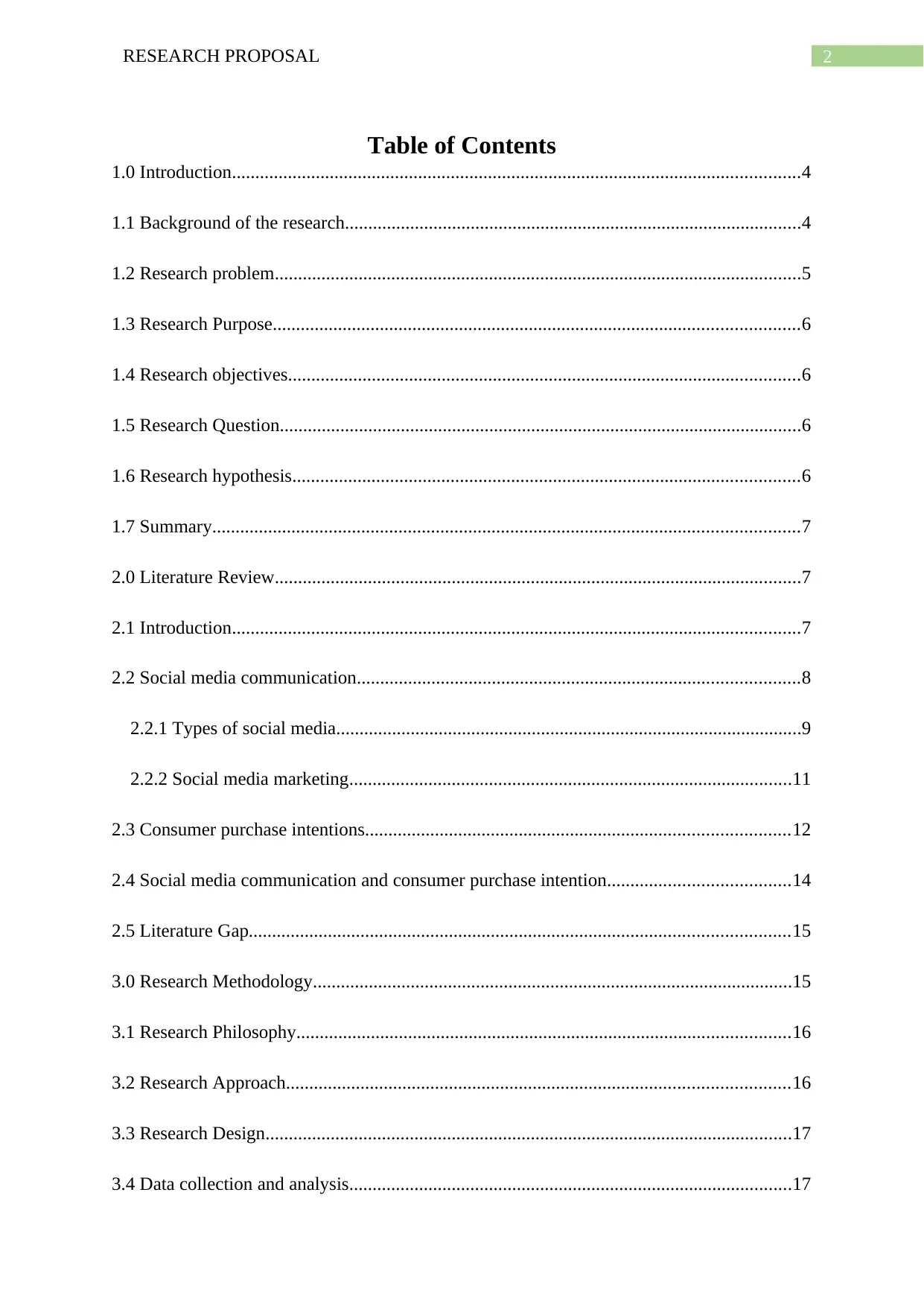
2RESEARCH PROPOSAL
Table of Contents
1.0 Introduction..........................................................................................................................4
1.1 Background of the research..................................................................................................4
1.2 Research problem.................................................................................................................5
1.3 Research Purpose.................................................................................................................6
1.4 Research objectives..............................................................................................................6
1.5 Research Question................................................................................................................6
1.6 Research hypothesis.............................................................................................................6
1.7 Summary..............................................................................................................................7
2.0 Literature Review.................................................................................................................7
2.1 Introduction..........................................................................................................................7
2.2 Social media communication...............................................................................................8
2.2.1 Types of social media....................................................................................................9
2.2.2 Social media marketing...............................................................................................11
2.3 Consumer purchase intentions...........................................................................................12
2.4 Social media communication and consumer purchase intention.......................................14
2.5 Literature Gap....................................................................................................................15
3.0 Research Methodology.......................................................................................................15
3.1 Research Philosophy..........................................................................................................16
3.2 Research Approach............................................................................................................16
3.3 Research Design.................................................................................................................17
3.4 Data collection and analysis...............................................................................................17
Table of Contents
1.0 Introduction..........................................................................................................................4
1.1 Background of the research..................................................................................................4
1.2 Research problem.................................................................................................................5
1.3 Research Purpose.................................................................................................................6
1.4 Research objectives..............................................................................................................6
1.5 Research Question................................................................................................................6
1.6 Research hypothesis.............................................................................................................6
1.7 Summary..............................................................................................................................7
2.0 Literature Review.................................................................................................................7
2.1 Introduction..........................................................................................................................7
2.2 Social media communication...............................................................................................8
2.2.1 Types of social media....................................................................................................9
2.2.2 Social media marketing...............................................................................................11
2.3 Consumer purchase intentions...........................................................................................12
2.4 Social media communication and consumer purchase intention.......................................14
2.5 Literature Gap....................................................................................................................15
3.0 Research Methodology.......................................................................................................15
3.1 Research Philosophy..........................................................................................................16
3.2 Research Approach............................................................................................................16
3.3 Research Design.................................................................................................................17
3.4 Data collection and analysis...............................................................................................17
⊘ This is a preview!⊘
Do you want full access?
Subscribe today to unlock all pages.

Trusted by 1+ million students worldwide

3RESEARCH PROPOSAL
3.5 Sampling method...............................................................................................................18
3.6 Reliability and Validity......................................................................................................18
3.7 Ethical consideration..........................................................................................................19
References................................................................................................................................20
3.5 Sampling method...............................................................................................................18
3.6 Reliability and Validity......................................................................................................18
3.7 Ethical consideration..........................................................................................................19
References................................................................................................................................20
Paraphrase This Document
Need a fresh take? Get an instant paraphrase of this document with our AI Paraphraser
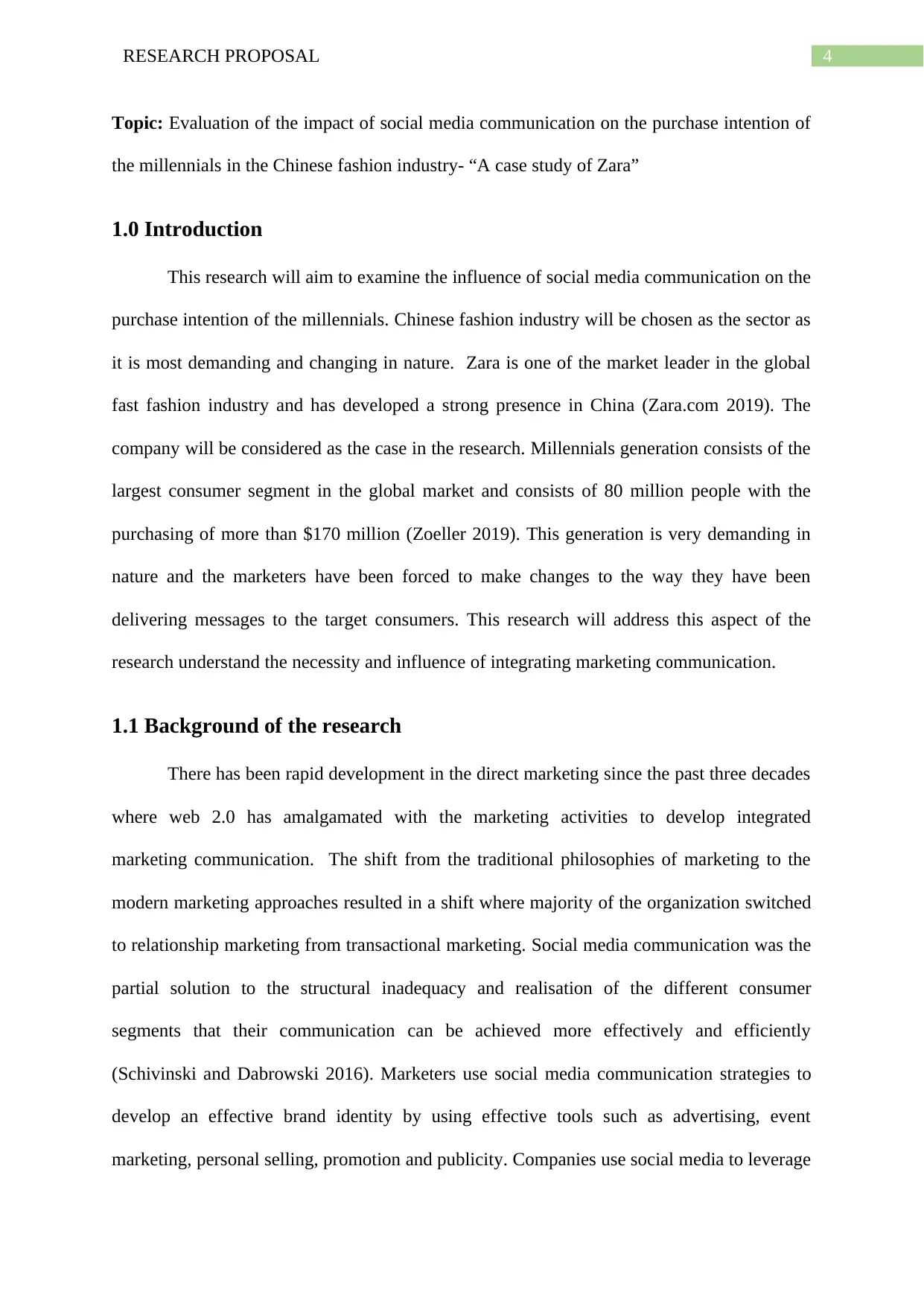
4RESEARCH PROPOSAL
Topic: Evaluation of the impact of social media communication on the purchase intention of
the millennials in the Chinese fashion industry- “A case study of Zara”
1.0 Introduction
This research will aim to examine the influence of social media communication on the
purchase intention of the millennials. Chinese fashion industry will be chosen as the sector as
it is most demanding and changing in nature. Zara is one of the market leader in the global
fast fashion industry and has developed a strong presence in China (Zara.com 2019). The
company will be considered as the case in the research. Millennials generation consists of the
largest consumer segment in the global market and consists of 80 million people with the
purchasing of more than $170 million (Zoeller 2019). This generation is very demanding in
nature and the marketers have been forced to make changes to the way they have been
delivering messages to the target consumers. This research will address this aspect of the
research understand the necessity and influence of integrating marketing communication.
1.1 Background of the research
There has been rapid development in the direct marketing since the past three decades
where web 2.0 has amalgamated with the marketing activities to develop integrated
marketing communication. The shift from the traditional philosophies of marketing to the
modern marketing approaches resulted in a shift where majority of the organization switched
to relationship marketing from transactional marketing. Social media communication was the
partial solution to the structural inadequacy and realisation of the different consumer
segments that their communication can be achieved more effectively and efficiently
(Schivinski and Dabrowski 2016). Marketers use social media communication strategies to
develop an effective brand identity by using effective tools such as advertising, event
marketing, personal selling, promotion and publicity. Companies use social media to leverage
Topic: Evaluation of the impact of social media communication on the purchase intention of
the millennials in the Chinese fashion industry- “A case study of Zara”
1.0 Introduction
This research will aim to examine the influence of social media communication on the
purchase intention of the millennials. Chinese fashion industry will be chosen as the sector as
it is most demanding and changing in nature. Zara is one of the market leader in the global
fast fashion industry and has developed a strong presence in China (Zara.com 2019). The
company will be considered as the case in the research. Millennials generation consists of the
largest consumer segment in the global market and consists of 80 million people with the
purchasing of more than $170 million (Zoeller 2019). This generation is very demanding in
nature and the marketers have been forced to make changes to the way they have been
delivering messages to the target consumers. This research will address this aspect of the
research understand the necessity and influence of integrating marketing communication.
1.1 Background of the research
There has been rapid development in the direct marketing since the past three decades
where web 2.0 has amalgamated with the marketing activities to develop integrated
marketing communication. The shift from the traditional philosophies of marketing to the
modern marketing approaches resulted in a shift where majority of the organization switched
to relationship marketing from transactional marketing. Social media communication was the
partial solution to the structural inadequacy and realisation of the different consumer
segments that their communication can be achieved more effectively and efficiently
(Schivinski and Dabrowski 2016). Marketers use social media communication strategies to
develop an effective brand identity by using effective tools such as advertising, event
marketing, personal selling, promotion and publicity. Companies use social media to leverage
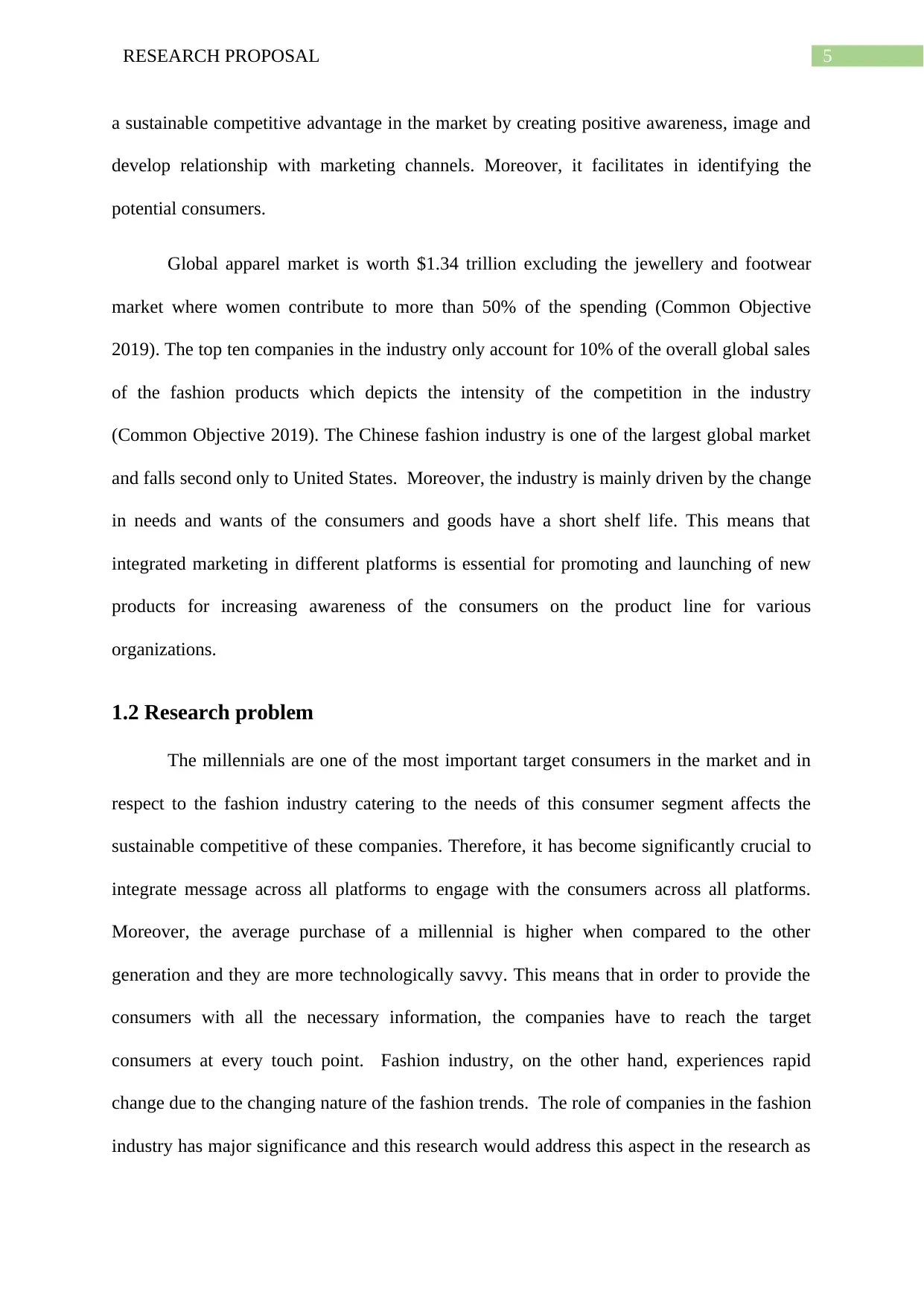
5RESEARCH PROPOSAL
a sustainable competitive advantage in the market by creating positive awareness, image and
develop relationship with marketing channels. Moreover, it facilitates in identifying the
potential consumers.
Global apparel market is worth $1.34 trillion excluding the jewellery and footwear
market where women contribute to more than 50% of the spending (Common Objective
2019). The top ten companies in the industry only account for 10% of the overall global sales
of the fashion products which depicts the intensity of the competition in the industry
(Common Objective 2019). The Chinese fashion industry is one of the largest global market
and falls second only to United States. Moreover, the industry is mainly driven by the change
in needs and wants of the consumers and goods have a short shelf life. This means that
integrated marketing in different platforms is essential for promoting and launching of new
products for increasing awareness of the consumers on the product line for various
organizations.
1.2 Research problem
The millennials are one of the most important target consumers in the market and in
respect to the fashion industry catering to the needs of this consumer segment affects the
sustainable competitive of these companies. Therefore, it has become significantly crucial to
integrate message across all platforms to engage with the consumers across all platforms.
Moreover, the average purchase of a millennial is higher when compared to the other
generation and they are more technologically savvy. This means that in order to provide the
consumers with all the necessary information, the companies have to reach the target
consumers at every touch point. Fashion industry, on the other hand, experiences rapid
change due to the changing nature of the fashion trends. The role of companies in the fashion
industry has major significance and this research would address this aspect in the research as
a sustainable competitive advantage in the market by creating positive awareness, image and
develop relationship with marketing channels. Moreover, it facilitates in identifying the
potential consumers.
Global apparel market is worth $1.34 trillion excluding the jewellery and footwear
market where women contribute to more than 50% of the spending (Common Objective
2019). The top ten companies in the industry only account for 10% of the overall global sales
of the fashion products which depicts the intensity of the competition in the industry
(Common Objective 2019). The Chinese fashion industry is one of the largest global market
and falls second only to United States. Moreover, the industry is mainly driven by the change
in needs and wants of the consumers and goods have a short shelf life. This means that
integrated marketing in different platforms is essential for promoting and launching of new
products for increasing awareness of the consumers on the product line for various
organizations.
1.2 Research problem
The millennials are one of the most important target consumers in the market and in
respect to the fashion industry catering to the needs of this consumer segment affects the
sustainable competitive of these companies. Therefore, it has become significantly crucial to
integrate message across all platforms to engage with the consumers across all platforms.
Moreover, the average purchase of a millennial is higher when compared to the other
generation and they are more technologically savvy. This means that in order to provide the
consumers with all the necessary information, the companies have to reach the target
consumers at every touch point. Fashion industry, on the other hand, experiences rapid
change due to the changing nature of the fashion trends. The role of companies in the fashion
industry has major significance and this research would address this aspect in the research as
⊘ This is a preview!⊘
Do you want full access?
Subscribe today to unlock all pages.

Trusted by 1+ million students worldwide
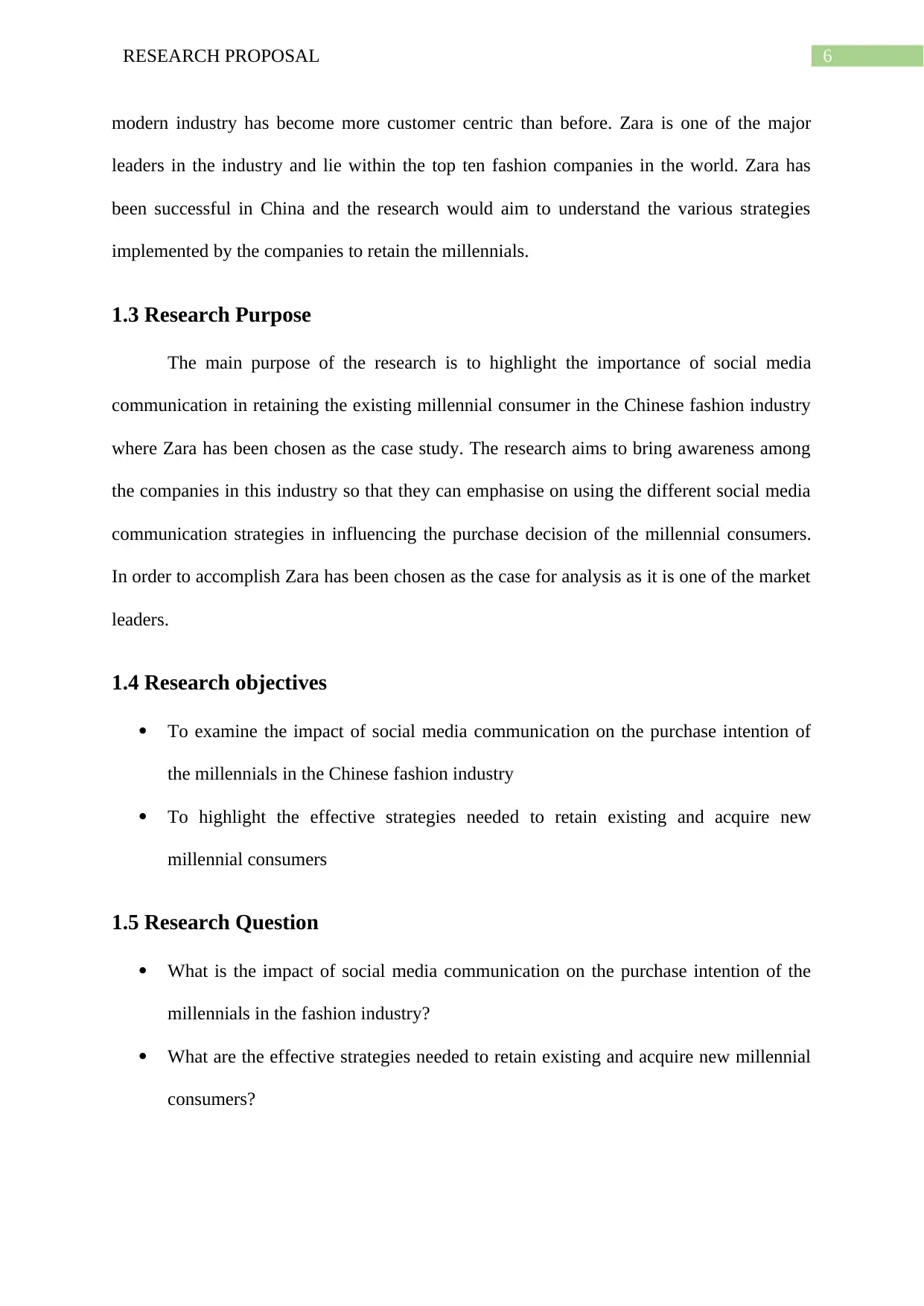
6RESEARCH PROPOSAL
modern industry has become more customer centric than before. Zara is one of the major
leaders in the industry and lie within the top ten fashion companies in the world. Zara has
been successful in China and the research would aim to understand the various strategies
implemented by the companies to retain the millennials.
1.3 Research Purpose
The main purpose of the research is to highlight the importance of social media
communication in retaining the existing millennial consumer in the Chinese fashion industry
where Zara has been chosen as the case study. The research aims to bring awareness among
the companies in this industry so that they can emphasise on using the different social media
communication strategies in influencing the purchase decision of the millennial consumers.
In order to accomplish Zara has been chosen as the case for analysis as it is one of the market
leaders.
1.4 Research objectives
To examine the impact of social media communication on the purchase intention of
the millennials in the Chinese fashion industry
To highlight the effective strategies needed to retain existing and acquire new
millennial consumers
1.5 Research Question
What is the impact of social media communication on the purchase intention of the
millennials in the fashion industry?
What are the effective strategies needed to retain existing and acquire new millennial
consumers?
modern industry has become more customer centric than before. Zara is one of the major
leaders in the industry and lie within the top ten fashion companies in the world. Zara has
been successful in China and the research would aim to understand the various strategies
implemented by the companies to retain the millennials.
1.3 Research Purpose
The main purpose of the research is to highlight the importance of social media
communication in retaining the existing millennial consumer in the Chinese fashion industry
where Zara has been chosen as the case study. The research aims to bring awareness among
the companies in this industry so that they can emphasise on using the different social media
communication strategies in influencing the purchase decision of the millennial consumers.
In order to accomplish Zara has been chosen as the case for analysis as it is one of the market
leaders.
1.4 Research objectives
To examine the impact of social media communication on the purchase intention of
the millennials in the Chinese fashion industry
To highlight the effective strategies needed to retain existing and acquire new
millennial consumers
1.5 Research Question
What is the impact of social media communication on the purchase intention of the
millennials in the fashion industry?
What are the effective strategies needed to retain existing and acquire new millennial
consumers?
Paraphrase This Document
Need a fresh take? Get an instant paraphrase of this document with our AI Paraphraser
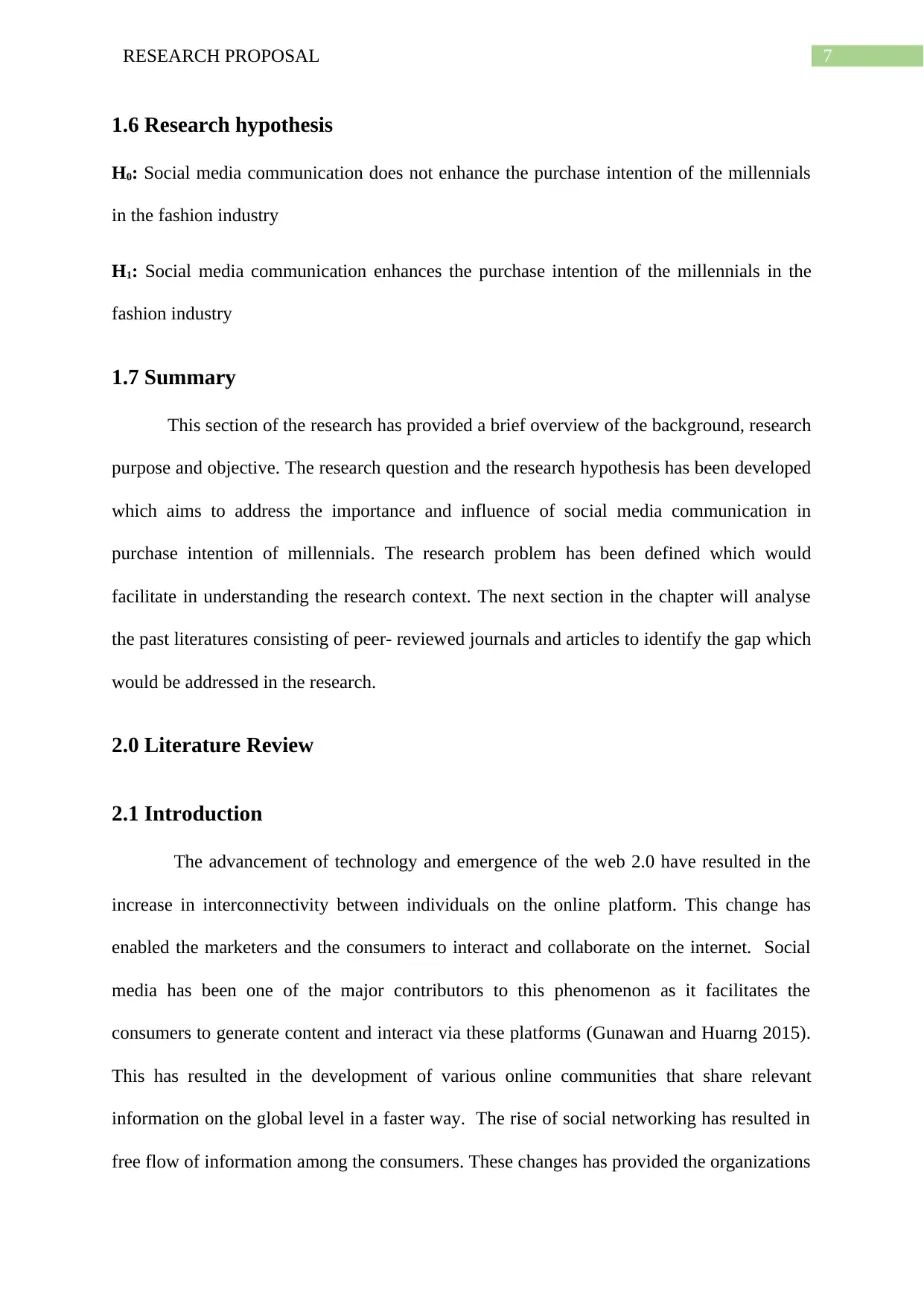
7RESEARCH PROPOSAL
1.6 Research hypothesis
H0: Social media communication does not enhance the purchase intention of the millennials
in the fashion industry
H1: Social media communication enhances the purchase intention of the millennials in the
fashion industry
1.7 Summary
This section of the research has provided a brief overview of the background, research
purpose and objective. The research question and the research hypothesis has been developed
which aims to address the importance and influence of social media communication in
purchase intention of millennials. The research problem has been defined which would
facilitate in understanding the research context. The next section in the chapter will analyse
the past literatures consisting of peer- reviewed journals and articles to identify the gap which
would be addressed in the research.
2.0 Literature Review
2.1 Introduction
The advancement of technology and emergence of the web 2.0 have resulted in the
increase in interconnectivity between individuals on the online platform. This change has
enabled the marketers and the consumers to interact and collaborate on the internet. Social
media has been one of the major contributors to this phenomenon as it facilitates the
consumers to generate content and interact via these platforms (Gunawan and Huarng 2015).
This has resulted in the development of various online communities that share relevant
information on the global level in a faster way. The rise of social networking has resulted in
free flow of information among the consumers. These changes has provided the organizations
1.6 Research hypothesis
H0: Social media communication does not enhance the purchase intention of the millennials
in the fashion industry
H1: Social media communication enhances the purchase intention of the millennials in the
fashion industry
1.7 Summary
This section of the research has provided a brief overview of the background, research
purpose and objective. The research question and the research hypothesis has been developed
which aims to address the importance and influence of social media communication in
purchase intention of millennials. The research problem has been defined which would
facilitate in understanding the research context. The next section in the chapter will analyse
the past literatures consisting of peer- reviewed journals and articles to identify the gap which
would be addressed in the research.
2.0 Literature Review
2.1 Introduction
The advancement of technology and emergence of the web 2.0 have resulted in the
increase in interconnectivity between individuals on the online platform. This change has
enabled the marketers and the consumers to interact and collaborate on the internet. Social
media has been one of the major contributors to this phenomenon as it facilitates the
consumers to generate content and interact via these platforms (Gunawan and Huarng 2015).
This has resulted in the development of various online communities that share relevant
information on the global level in a faster way. The rise of social networking has resulted in
free flow of information among the consumers. These changes has provided the organizations
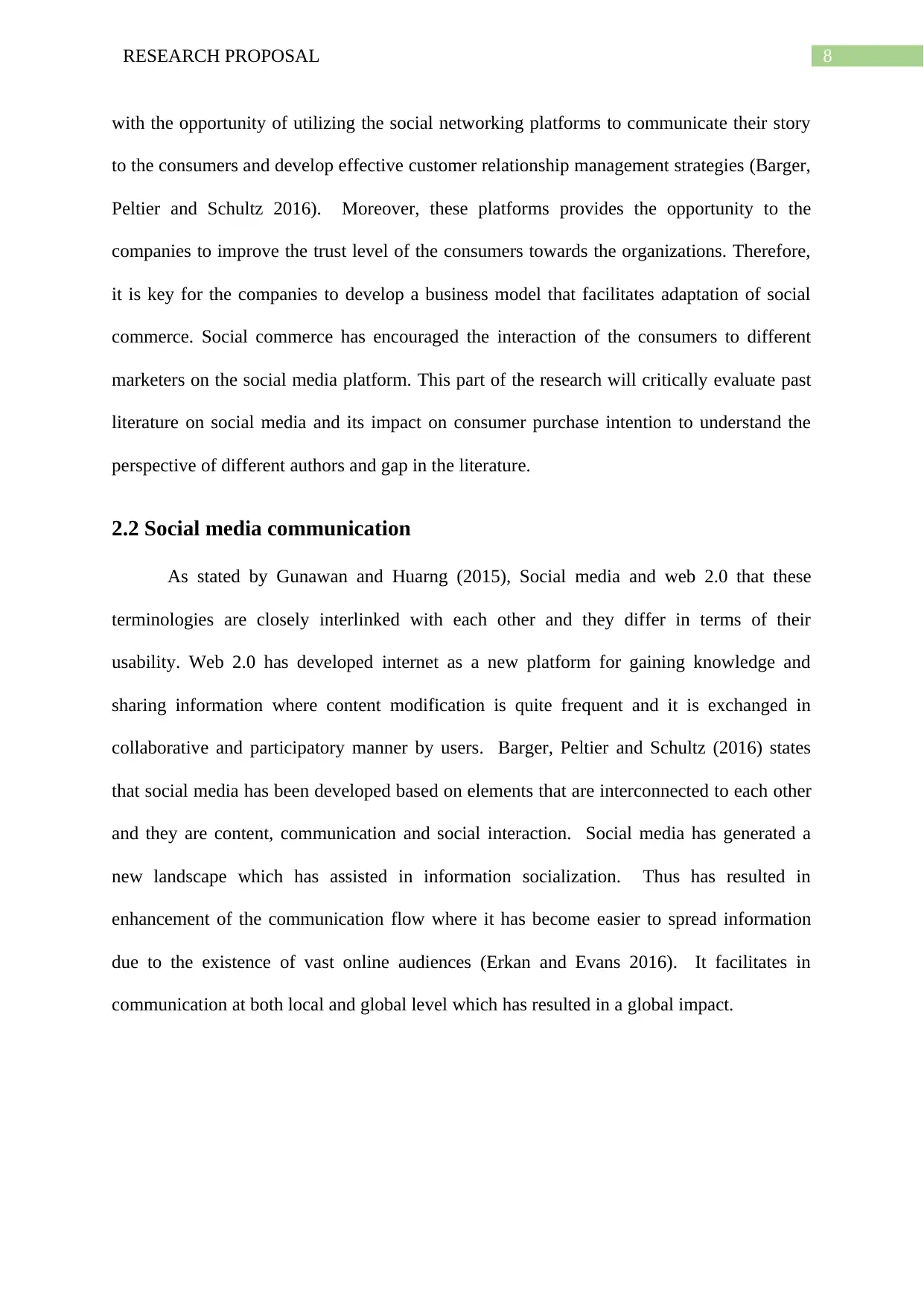
8RESEARCH PROPOSAL
with the opportunity of utilizing the social networking platforms to communicate their story
to the consumers and develop effective customer relationship management strategies (Barger,
Peltier and Schultz 2016). Moreover, these platforms provides the opportunity to the
companies to improve the trust level of the consumers towards the organizations. Therefore,
it is key for the companies to develop a business model that facilitates adaptation of social
commerce. Social commerce has encouraged the interaction of the consumers to different
marketers on the social media platform. This part of the research will critically evaluate past
literature on social media and its impact on consumer purchase intention to understand the
perspective of different authors and gap in the literature.
2.2 Social media communication
As stated by Gunawan and Huarng (2015), Social media and web 2.0 that these
terminologies are closely interlinked with each other and they differ in terms of their
usability. Web 2.0 has developed internet as a new platform for gaining knowledge and
sharing information where content modification is quite frequent and it is exchanged in
collaborative and participatory manner by users. Barger, Peltier and Schultz (2016) states
that social media has been developed based on elements that are interconnected to each other
and they are content, communication and social interaction. Social media has generated a
new landscape which has assisted in information socialization. Thus has resulted in
enhancement of the communication flow where it has become easier to spread information
due to the existence of vast online audiences (Erkan and Evans 2016). It facilitates in
communication at both local and global level which has resulted in a global impact.
with the opportunity of utilizing the social networking platforms to communicate their story
to the consumers and develop effective customer relationship management strategies (Barger,
Peltier and Schultz 2016). Moreover, these platforms provides the opportunity to the
companies to improve the trust level of the consumers towards the organizations. Therefore,
it is key for the companies to develop a business model that facilitates adaptation of social
commerce. Social commerce has encouraged the interaction of the consumers to different
marketers on the social media platform. This part of the research will critically evaluate past
literature on social media and its impact on consumer purchase intention to understand the
perspective of different authors and gap in the literature.
2.2 Social media communication
As stated by Gunawan and Huarng (2015), Social media and web 2.0 that these
terminologies are closely interlinked with each other and they differ in terms of their
usability. Web 2.0 has developed internet as a new platform for gaining knowledge and
sharing information where content modification is quite frequent and it is exchanged in
collaborative and participatory manner by users. Barger, Peltier and Schultz (2016) states
that social media has been developed based on elements that are interconnected to each other
and they are content, communication and social interaction. Social media has generated a
new landscape which has assisted in information socialization. Thus has resulted in
enhancement of the communication flow where it has become easier to spread information
due to the existence of vast online audiences (Erkan and Evans 2016). It facilitates in
communication at both local and global level which has resulted in a global impact.
⊘ This is a preview!⊘
Do you want full access?
Subscribe today to unlock all pages.

Trusted by 1+ million students worldwide
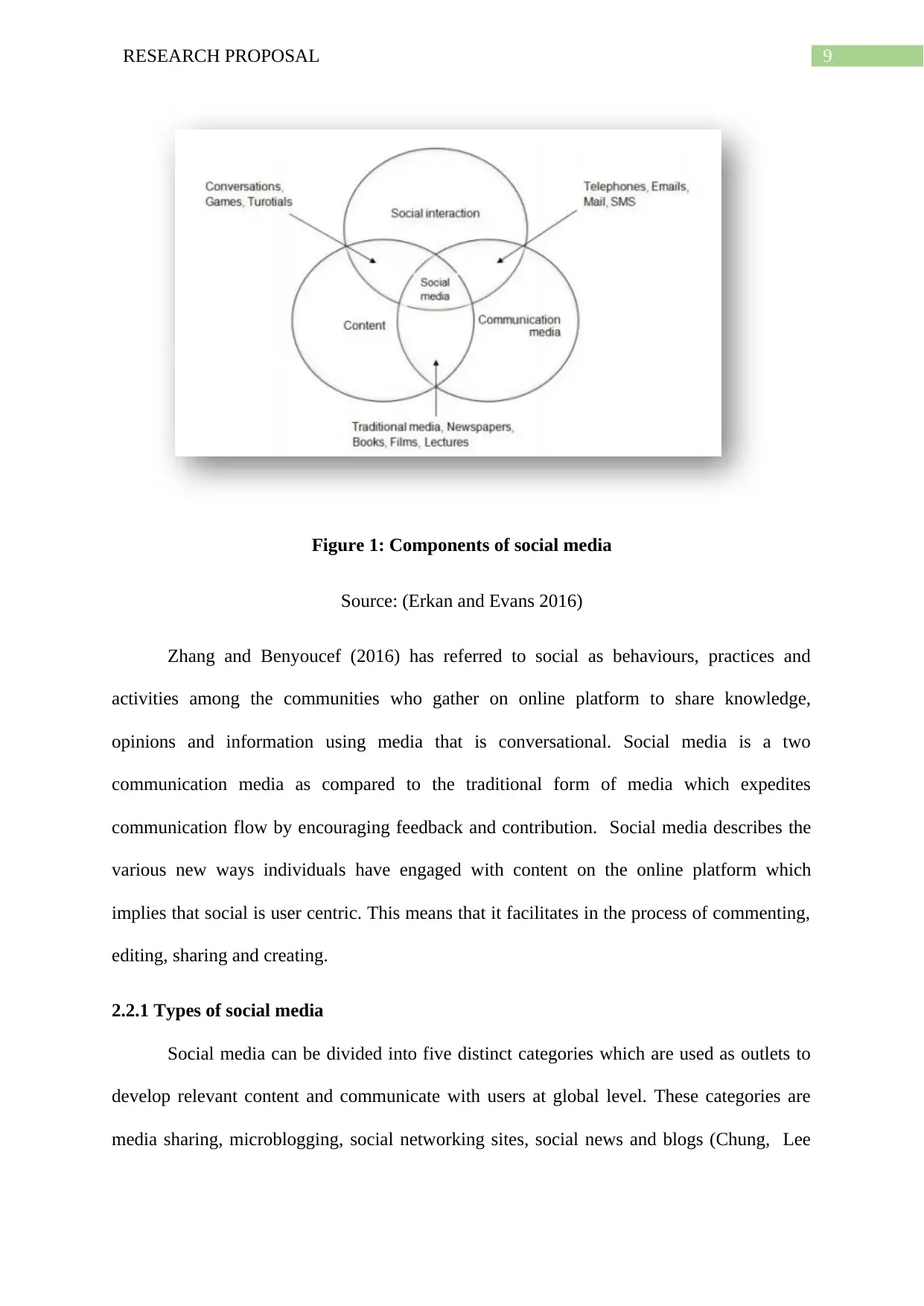
9RESEARCH PROPOSAL
Figure 1: Components of social media
Source: (Erkan and Evans 2016)
Zhang and Benyoucef (2016) has referred to social as behaviours, practices and
activities among the communities who gather on online platform to share knowledge,
opinions and information using media that is conversational. Social media is a two
communication media as compared to the traditional form of media which expedites
communication flow by encouraging feedback and contribution. Social media describes the
various new ways individuals have engaged with content on the online platform which
implies that social is user centric. This means that it facilitates in the process of commenting,
editing, sharing and creating.
2.2.1 Types of social media
Social media can be divided into five distinct categories which are used as outlets to
develop relevant content and communicate with users at global level. These categories are
media sharing, microblogging, social networking sites, social news and blogs (Chung, Lee
Figure 1: Components of social media
Source: (Erkan and Evans 2016)
Zhang and Benyoucef (2016) has referred to social as behaviours, practices and
activities among the communities who gather on online platform to share knowledge,
opinions and information using media that is conversational. Social media is a two
communication media as compared to the traditional form of media which expedites
communication flow by encouraging feedback and contribution. Social media describes the
various new ways individuals have engaged with content on the online platform which
implies that social is user centric. This means that it facilitates in the process of commenting,
editing, sharing and creating.
2.2.1 Types of social media
Social media can be divided into five distinct categories which are used as outlets to
develop relevant content and communicate with users at global level. These categories are
media sharing, microblogging, social networking sites, social news and blogs (Chung, Lee
Paraphrase This Document
Need a fresh take? Get an instant paraphrase of this document with our AI Paraphraser
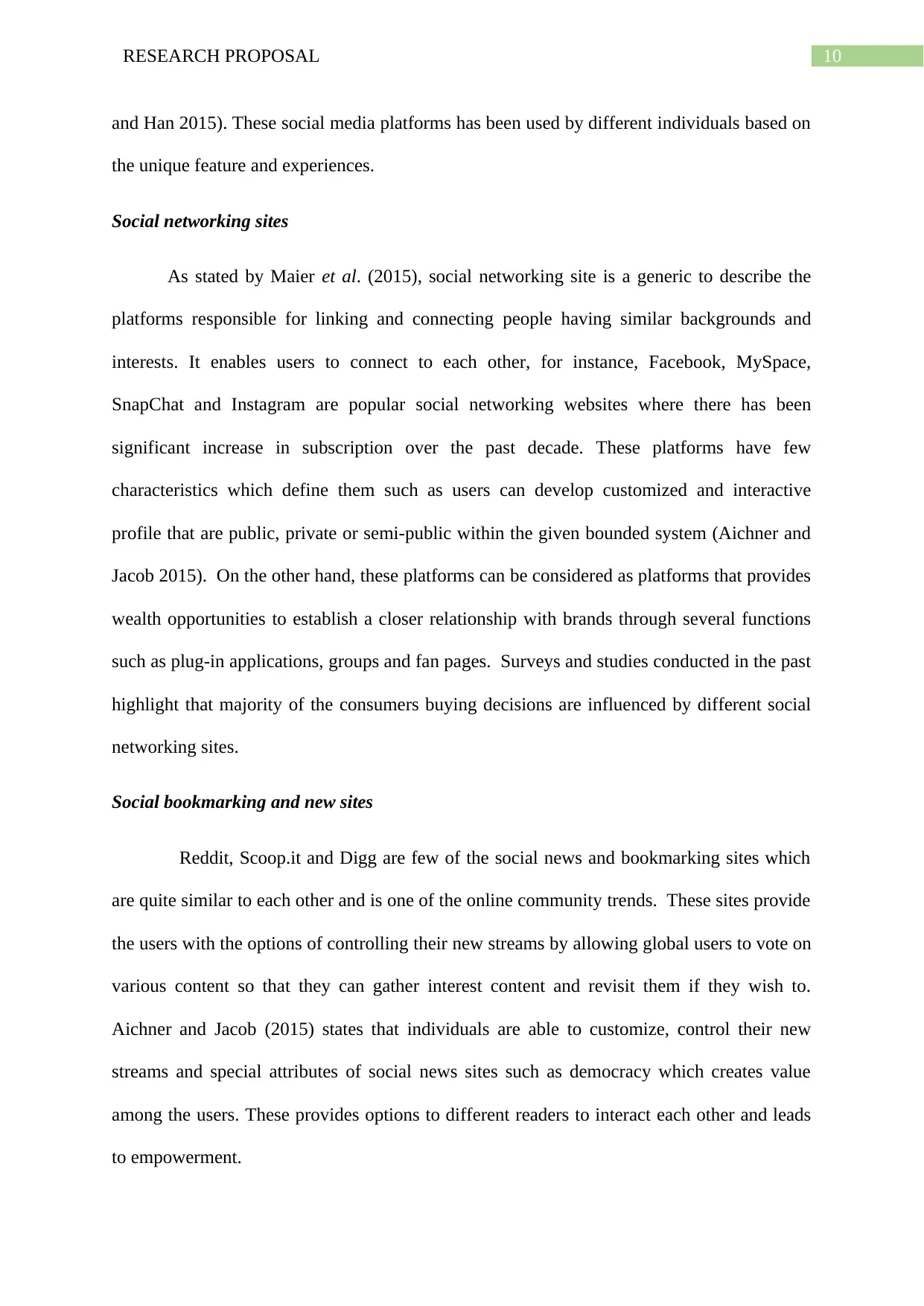
10RESEARCH PROPOSAL
and Han 2015). These social media platforms has been used by different individuals based on
the unique feature and experiences.
Social networking sites
As stated by Maier et al. (2015), social networking site is a generic to describe the
platforms responsible for linking and connecting people having similar backgrounds and
interests. It enables users to connect to each other, for instance, Facebook, MySpace,
SnapChat and Instagram are popular social networking websites where there has been
significant increase in subscription over the past decade. These platforms have few
characteristics which define them such as users can develop customized and interactive
profile that are public, private or semi-public within the given bounded system (Aichner and
Jacob 2015). On the other hand, these platforms can be considered as platforms that provides
wealth opportunities to establish a closer relationship with brands through several functions
such as plug-in applications, groups and fan pages. Surveys and studies conducted in the past
highlight that majority of the consumers buying decisions are influenced by different social
networking sites.
Social bookmarking and new sites
Reddit, Scoop.it and Digg are few of the social news and bookmarking sites which
are quite similar to each other and is one of the online community trends. These sites provide
the users with the options of controlling their new streams by allowing global users to vote on
various content so that they can gather interest content and revisit them if they wish to.
Aichner and Jacob (2015) states that individuals are able to customize, control their new
streams and special attributes of social news sites such as democracy which creates value
among the users. These provides options to different readers to interact each other and leads
to empowerment.
and Han 2015). These social media platforms has been used by different individuals based on
the unique feature and experiences.
Social networking sites
As stated by Maier et al. (2015), social networking site is a generic to describe the
platforms responsible for linking and connecting people having similar backgrounds and
interests. It enables users to connect to each other, for instance, Facebook, MySpace,
SnapChat and Instagram are popular social networking websites where there has been
significant increase in subscription over the past decade. These platforms have few
characteristics which define them such as users can develop customized and interactive
profile that are public, private or semi-public within the given bounded system (Aichner and
Jacob 2015). On the other hand, these platforms can be considered as platforms that provides
wealth opportunities to establish a closer relationship with brands through several functions
such as plug-in applications, groups and fan pages. Surveys and studies conducted in the past
highlight that majority of the consumers buying decisions are influenced by different social
networking sites.
Social bookmarking and new sites
Reddit, Scoop.it and Digg are few of the social news and bookmarking sites which
are quite similar to each other and is one of the online community trends. These sites provide
the users with the options of controlling their new streams by allowing global users to vote on
various content so that they can gather interest content and revisit them if they wish to.
Aichner and Jacob (2015) states that individuals are able to customize, control their new
streams and special attributes of social news sites such as democracy which creates value
among the users. These provides options to different readers to interact each other and leads
to empowerment.
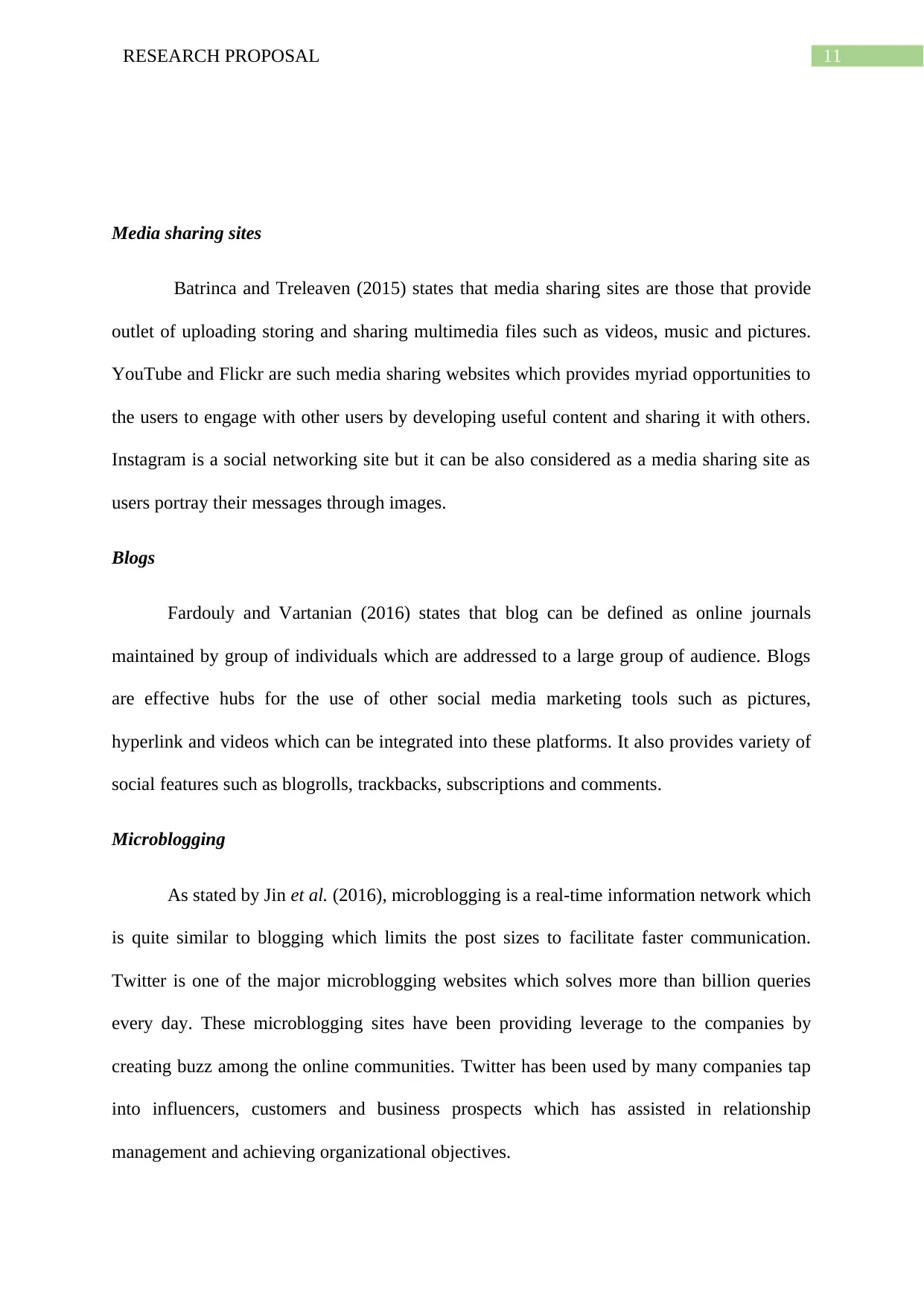
11RESEARCH PROPOSAL
Media sharing sites
Batrinca and Treleaven (2015) states that media sharing sites are those that provide
outlet of uploading storing and sharing multimedia files such as videos, music and pictures.
YouTube and Flickr are such media sharing websites which provides myriad opportunities to
the users to engage with other users by developing useful content and sharing it with others.
Instagram is a social networking site but it can be also considered as a media sharing site as
users portray their messages through images.
Blogs
Fardouly and Vartanian (2016) states that blog can be defined as online journals
maintained by group of individuals which are addressed to a large group of audience. Blogs
are effective hubs for the use of other social media marketing tools such as pictures,
hyperlink and videos which can be integrated into these platforms. It also provides variety of
social features such as blogrolls, trackbacks, subscriptions and comments.
Microblogging
As stated by Jin et al. (2016), microblogging is a real-time information network which
is quite similar to blogging which limits the post sizes to facilitate faster communication.
Twitter is one of the major microblogging websites which solves more than billion queries
every day. These microblogging sites have been providing leverage to the companies by
creating buzz among the online communities. Twitter has been used by many companies tap
into influencers, customers and business prospects which has assisted in relationship
management and achieving organizational objectives.
Media sharing sites
Batrinca and Treleaven (2015) states that media sharing sites are those that provide
outlet of uploading storing and sharing multimedia files such as videos, music and pictures.
YouTube and Flickr are such media sharing websites which provides myriad opportunities to
the users to engage with other users by developing useful content and sharing it with others.
Instagram is a social networking site but it can be also considered as a media sharing site as
users portray their messages through images.
Blogs
Fardouly and Vartanian (2016) states that blog can be defined as online journals
maintained by group of individuals which are addressed to a large group of audience. Blogs
are effective hubs for the use of other social media marketing tools such as pictures,
hyperlink and videos which can be integrated into these platforms. It also provides variety of
social features such as blogrolls, trackbacks, subscriptions and comments.
Microblogging
As stated by Jin et al. (2016), microblogging is a real-time information network which
is quite similar to blogging which limits the post sizes to facilitate faster communication.
Twitter is one of the major microblogging websites which solves more than billion queries
every day. These microblogging sites have been providing leverage to the companies by
creating buzz among the online communities. Twitter has been used by many companies tap
into influencers, customers and business prospects which has assisted in relationship
management and achieving organizational objectives.
⊘ This is a preview!⊘
Do you want full access?
Subscribe today to unlock all pages.

Trusted by 1+ million students worldwide
1 out of 24
Related Documents
Your All-in-One AI-Powered Toolkit for Academic Success.
+13062052269
info@desklib.com
Available 24*7 on WhatsApp / Email
![[object Object]](/_next/static/media/star-bottom.7253800d.svg)
Unlock your academic potential
Copyright © 2020–2025 A2Z Services. All Rights Reserved. Developed and managed by ZUCOL.





